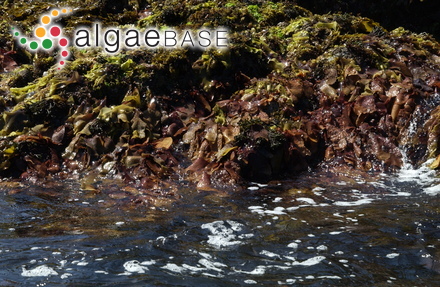Chondracanthus exasperatus (Harvey & Bailey) Hughey 1996

Current name:
Chondracanthus exasperatus (Harvey & Bailey) Hughey
Bamfield, Vancouver Island, Canada; plants at low water - 27 April 2004. Michael Guiry (mike.guiry@nuigalway.ie)
Publication Details
Chondracanthus exasperatus (Harvey & Bailey) Hughey 1996: 23
Published in: Hughey, J.R. Dudash, R. & Kjeldsen, C. K. (1996). A field and molecular systematic study on species of Chondracanthus (Gigartinales, Rhodophyceae) from Pacific North America. Journal of Phycology 32: 22-23.
Type Species
The type species (lectotype) of the genus Chondracanthus is Chondracanthus chauvinii (Bory) Kützing.
Status of Name
This name is of an entity that is currently accepted taxonomically.
Basionym
Gigartina exasperata Harvey & Bailey
Type Information
Type locality: Oposite Fort Nisqually, Puget Sound, Washington, USA; (Hughey & Hommersand 2008: 137) Lectotype: cystocarpic specimen: 1838-1842; TCD; 94544 (Hughey & Hommersand 2008: 137)
General Environment
This is a marine species.
Description
Thalli 20-70 cm tall, fleshy or crisp, yellowish-
green to brownish-red in sheltered habitats, brick
red (north of Point Conception and in Baja California) or
pink (south of Point Conception to the Mexican border) on
exposed coasts, consisting of one to several blades from
a discoid holdfast up to 1 cm broad; blades 6-
20 cm wide, 0.2-3 mm thick, simple or forked, lanceolate to
long-elliptical and tapered to a blunt or acuminate tip, the
margins entire or dentate or sometimes bearing bladelets;
stipitate, the stipe usually 2-3 cm long bearing lateral
bladelets and expanding to a short, fleshy and flattened
cuneate base; surface and margins of blades, except the base
covered with closely to widely spaced, spinose outgrowths;
cortex 5-7 cell layers thick; medullary cells variable in size
and shape, 1.5-24 mm in width. Spermatangial sori
superficial, indefinite on slender, elongate papillae with
thin attenuating tips. Gonimoblast forming a compact
group of cells around the auxiliary cell with
cortical and medullary cells producing short-celled filaments
circling the gonimoblasts; later in development,
a well-defined envelope composed of short and
dense filaments forms to surround the carposporophyte. Cystocarps 0.8-1.5 mm in diameter, hemispherical,
frequently fusing to form a single, compound
cystocarp, located in papillae that are sometimes
ornamented with spines, 1-3 per papilla.
Carpospores subspherical, 12-18 µm in diameter, at
maturity released through an ostiole. Tetrasporangial
sori 0.2-1 mm in diameter, developing
at the junction between the emerging papilla and the blade. Tetrasporangia 34-42 µm in diameter, transforming
from primary cortical filaments in branched chains 9-12
cells long. As the papilla grows, the new
primary cortical filaments are transformed into tetrasporangial
chains, sometimes forming 2-3 hemiispherical
rings of sori on the nipple-like papillae. At
maturity tetraspores are released through cracks in the
cortical wall, leaving behind an empty cavity.
Habitat
Low intertidal, exposed rocky headlands to sheltered localities.
Created: 13 April 1998 by M.D. Guiry.
Last updated: 22 August 2013
Verification of Data
Users are responsible for verifying the accuracy of information before use, as noted on the website Content page.
Linking to this page: https://www.algaebase.org/search/species/detail/?species_id=4937
Citing AlgaeBase
Cite this record as:
M.D. Guiry in Guiry, M.D. & Guiry, G.M. 22 August 2013. AlgaeBase. World-wide electronic publication, National University of Ireland, Galway. https://www.algaebase.org; searched on 08 January 2025















